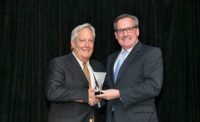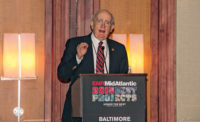Even as a young kid growing up in Harrisburg, Pa., Steve Sandherr saw big things on the horizon. “I knew when I was 10 years old that I was going to major in political science in college and go to law school,” he recalls. “Nobody in my family had graduated from college and obviously there were no lawyers in my family, but I was interested at a young age in politics.”
Fifty-five years later, Sandherr is about to retire after a successful career that took him from the halls of Congress to the heights of the construction industry.
On March 31, Sandherr will step down as CEO of Associated General Contractors of America after 27 years at the helm of an organization that today boasts approximately 90 chapters nationwide and more than 27,000 member firms. Under his leadership, Sandherr served a diverse membership base, including large and small businesses; general and specialty contractors; and union and nonunion shops.
Throughout his tenure he balanced the broad range of member needs, which sometimes were at odds with each other, to find solutions that ultimately advanced the industry. Noted by colleagues for his candor and his ability to listen, communicate and collaborate, Sandherr had a hand in initiatives that helped advance member firms and the industry as a whole. In light of his years of service, ENR MidAtlantic names Sandherr to receive its 2024 Legacy Award.

Sandherr and industry partners spent decades promoting the importance of dedicated infrastructure funding.
Photo courtesy AGC of America
A Skill Set for Service
Attending the University of Scranton, a private Catholic college in Scranton, Pa., Sandherr earned a bachelor’s degree in political science, becoming the first in his family to graduate from college. He then rounded out his skill set by attending The Catholic University of America Columbus School of Law in Washington, D.C.
After he graduated, Sandherr remained focused on public policy rather than practicing law. “Legal training makes you a lot more analytical,” he says. “You learn how to understand an argument and pick it apart. You learn to challenge assumptions, how to see potential conflicts and mitigate concerns.”
“We all need purpose in our life, and I found that the opportunity I've had at AGC has given me the honor of representing people that are trying to do good.”
— Steve Sandherr, CEO, Associated General Contractors of America
Graduating from law school in 1984, Sandherr saw an ad for a position at a construction trade association looking for someone with labor law experience. In law school, he took a class called “Labor Relations in the Construction Industry,” which he says he was interested in “because there’s a lot of sociology” in labor law. Ultimately, that course helped establish the arc of his career. “I took that course and figured that counted as experience, so I applied and [AGC] hired me.” The position was assistant director for collective bargaining services.
Sandherr spent the next two years working on labor relations, including working with members of Congress on legislation such as a construction labor law reform bill. Those efforts led Sandherr to take on duties as an AGC lobbyist. After five years at AGC, however, Sandherr says he didn’t see a future path at the association, so he accepted an offer to join a law firm. After just over a year there, he transitioned back to the construction association world, taking a job with the National Association of Home Builders. About a year later, the opportunity he wanted at AGC opened up and he was wooed back to the organization, taking on the role of executive director for congressional relations in January 1991.

Beyond his lobbying efforts on Capitol Hill, Sandherr championed the importance of initiatives such as safety, mental health and diversity and inclusion.
Photo courtesy AGC of America
Finding Purpose
Sandherr flourished in his new role, bringing to bear not only his legal and lobbying background, but applying the values that he learned growing up in a devout Catholic household. “We’re taught to love others as ourselves and to give respect and dignity to other human beings,” he says.
In that respect, Sandherr says he found AGC was a good fit, working for members who primarily represent small, family-owned businesses. “I’ve always felt comfortable being an advocate for AGC,” he says. “Our members provide career and job opportunities for people that add to our built environment. They prioritize maintaining a safe workplace, recognizing that they have a moral obligation to do so, not a legal obligation. We all need purpose in our life, and I found that the opportunity I’ve had at AGC has given me the honor of representing people that are trying to do good.”
Five years into his government relations role, the CEO position at AGC opened up. At that time, Sandherr recalls that AGC was struggling with relationships between national staff and chapter executives. Over time, trust in AGC had eroded at the chapter level, and some chapters even threatened to leave. Initially, he says AGC thought bringing in an outsider to lead the association would be the best strategy. However, when that did not pan out, the position was opened to internal candidates. Sandherr applied, and in January 1997, at the age of 38, he took the helm of the oldest and largest construction association representing general and specialty contractors.
Right away, his leadership skills were put to the test, as he set about restoring relationships with the chapters. Sandherr found that his years of working in government relations proved effective in finding common ground. “I was already going out to AGC chapters and explaining issues, which was good training for the job I ultimately got,” he says.
“I see him as a mentor in the association world.”
— Ed Brady, President & CEO, Home Builders Institute
Part of the strategy included meeting directly with chapter executives, sometimes during meetings or training sessions at the headquarters, other times at chapter offices. That drive to connect directly with others led to a career of travel, often spending more than 100 nights per year on the road.
“You need to be available and accessible in person, to have the opportunity to tell people about what we’re doing on their behalf, to pick up new ideas from chapters and members, to address peoples’ concerns, to have an opportunity to clarify where there might be a misunderstanding,” he says. “You have to be able to demonstrate the value of the relationship.”
Over time, Sandherr and his team restored relations. Rich Barcaskey, executive director of Constructors Association of Western Pennsylvania, says that as the head of an AGC chapter, he appreciates Sandherr’s candor, even when he represents positions that are counter to those of his union members.
“If there is ever an issue, like project labor agreements, where AGC was going to take a position that could upset our [union] members, he would always give you a heads up, explain why they were taking that position and give you the bullet points,” he says.
Barcaskey says that level of honesty gave Sandherr added credibility. “I’ve seen other association leaders speak, and they just tell you what you want to hear, then they go do something else,” he says. “Steve lays it out honestly. If things aren’t ideal, he tells you, and then he lets you know that you have to adapt.”

In addition to advocating for AGC members, Sandherr tackled big picture issues with industry partners.
Photo courtesy AGC of America
Industry Influence
Sandherr’s peers also appreciated his approach, particularly when working through issues that rise to an industry level. Ed Brady, president and CEO of the Home Builders Institute, says Sandherr has been a respected partner on multiple shared initiatives, including workforce issues. “Steve is very collaborative and recognizes that united we are stronger,” he says. “He’s laser-focused on the direction of his association, but he always has the bigger picture in mind. We’ve counseled each other over the years during challenges we’ve faced. I see him as a mentor in the association world.”
Tom Gilbane Jr., chairman and CEO of Gilbane Inc., agrees that Sandherr’s ability to work effectively with industry partners—among members and outside the organization—was one of his strengths. “He’s so respected and has an ability to network and be known both within various government agencies, but also in business groups,” Gilbane says. “He’s able to coalesce groups together around industry issues, whether it’s on safety, mental health or diversity and inclusion.”
Among the most significant initiatives on which Sandherr partnered was the decades-long messaging push about the importance of infrastructure investment. Those efforts culminated in the passage of the landmark $1.2-trillion Infrastructure Investment and Jobs Act in 2021.
Tom Smith, American Society of Civil Engineers executive director, who worked with Sandherr through industry groups like the Transportation Construction Coalition, says Sandherr has had a remarkable tenure and leadership track record at AGC, earning respect within the association and infrastructure communities. “I’ve known Steve for a couple decades now and have always enjoyed his frank and effective communication style, coupled with a tremendous sense of humor,” Smith says. “Among many successes, it was wonderful to see the Bipartisan Infrastructure Law cross the finish line before Steve’s well-earned retirement.”
For Sandherr, some of his proudest moments came during the industry’s darkest times. During the recession in 2008 and 2009, as construction companies were hemorrhaging workers and trade associations were furloughing staff, AGC did not lay off a single employee. “There was pressure on me from our leaders to lay people off and my response was, ‘You’re laying people off because you have less work,’” he recalls. “‘We don’t have less work. We have more work.’”
“He’s able to coalesce groups together around industry issues, whether it’s on safety, mental health or diversity and inclusion.”
— Tom Gilbane Jr., Chairman & CEO, Gilbane Inc.
From an advocacy perspective, he says one of AGC’s shining moments came during the first year of the pandemic, as his team worked to get construction recognized as an essential service. As part of that mission, his team worked with members, asking them to do their part and provide safe work environments that adhered to COVID-related requirements. “We reminded our members that we’ve gotten this green light, but we have to act in a responsible fashion,” he says. “Our members responded well. They saw that was the ticket that kept them operating.”
Although proud of his team’s accomplishments, Sandherr admits he is retiring with some unfinished business. “I would say the biggest disappointment from an advocacy perspective was in 2008 and 2013, when we did not get comprehensive immigration reform passed in Congress,” he says. “Because of that we have a huge mess on our hands today.”
As Sandherr steps away, his post will be filled by current COO Jeff Shoaf. Like Sandherr, Shoaf spent years working in government relations at AGC. Although they followed a similar path, Sandherr says it’s time for AGC to take a new direction. “He’s the right person for the job—so there should be a lot of continuity, even though he’ll do some things a little differently, which is a good thing,” he says. “Maybe he can shake things up.”





Post a comment to this article
Report Abusive Comment